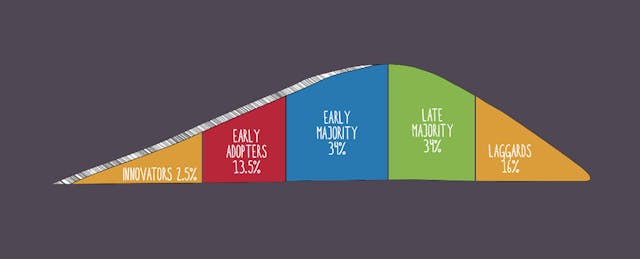Whether a district has limited resources or in-house expertise, anyone can move toward personalizing learning by using our district's approach as a blueprint. Why? Our approach is informed by both theory and the good work of our colleagues across the nation. If you feel you have arrived late to blended and personalized learning, relax. Everyone is figuring it out, and districts are amazingly willing to share their successes and their missteps.
Our approach in Frederick County Public Schools (FCPS) is informed by the “Diffusion of Innovations” field (originally forwarded by Everett Rogers), and focused on (a) viewing our teachers as consumers and (b) designing the initiative with qualities that promote rapid adoption in the district.
Choice: Focus on “Innovators” and “Early Adopters” over “Laggards” and “Late Majority”

Rogers identified five cohorts of consumers who adopt innovations. Innovators are the tiny percentage (2.5%) who are leading change by prototyping and iterating, with early adopters (13.5%) being those who join quickly thereafter because they intuitively connect the innovation to their own work and drives. Rodgers’ early majority, late majority and laggards adopt later for a number of reasons.
We see our teachers in these cohorts. But we note that they are not consumers in the sense of exchanging money for good or services, but rather as investing considerable time, energy and passion (the currency of teaching) in the blended learning innovation. Our initiative, to date, only targets our innovators and early adopters, and is based on identifying these innovation leaders by having them opt in. We suggest you start here as well, even if your district has the funds to work with more teachers. Your return on investment will be better, you’ll create successful use cases, and these teachers will be instrumental in diffusing the innovation throughout the district.
So, how are we doing this?
Collaboration: Bring Together Teachers, Curriculum Teams, and “Subject Matter Experts”
We started through curriculum projects, which are small field tests designed to create an enabling environment for teachers. Our curriculum team works directly with teachers in schools to solve an instructional problem by designing a specific model of blended learning, building the classroom structures and instructional resources to support the model, and learning and iterating together.
Sue Ann Nogle and her secondary English Language Arts team kicked the projects off in English 9 at Oakdale High School in collaboration with subject matter experts (SMEs) from Houghton Mifflin Harcourt (HMH). HMH and our district provided the students in the five blended classrooms with devices they could use all day and take home. The SMEs assisted our teachers and curriculum team in navigating the digital tools in the HMH Collections series and leveraging those resources into the station rotation blended model.
Parallel to this work, we build capacity across our curriculum team by focusing heavily on Michael Horn and Heather Staker’s book Blended: Using disruptive innovation to improve schools and resources from the Clayton Christensen Institute. We held book studies and blended learning retreats to build a vision of our instructional model, develop planning tools for future curriculum projects, and address any questions and concerns of our team.
The preliminary results were promising, so the project expanded to three other high school this semester and is moving up to Grade 10 at the original site.
Capacity: Let the “Innovator” Teachers Develop the Professional Development
Building teacher capacity was a key focus for our team. We had been developing an initial plan for some type of teacher professional learning program in the previous year, so when we heard about the Vanguard program in Fulton County Schools in Georgia, we reached out to Stephanee Stephens, then director of the Vanguard program and now director at Kennesaw State University's iTeach Program, to understand how they approached teacher learning. This collaboration proved critical to our success; Fulton staff shared resources, heard our ideas, and offered suggestions.
So, we invited a representative group of our teachers to craft a three year professional learning program for blended, personalized learning that they believed their colleagues would seek to join. What resulted was the FCPS Vanguard Teacher Program (a proud “Vanchise” of the Fulton program). We developed a website for the program, held information nights, and promoted the program through video, social media and word of mouth for more than six months. “Starting a buzz” around blended learning was a foundational part of our strategy.
As noted above, using Rogers’ work is helping us design the initiative with the qualities he identified as most likely to promote a rapid adoption of blended learning. In both the curriculum projects and the Vanguard Teacher program we will be helping teachers see:
- the relative advantage blended learning has over more traditional teaching and learning, and as measured by what really matters to them (increased engagement, more opportunities to provide feedback, stronger relationships with students, etc.);
- the compatibility with their current work and core beliefs, especially emphasizing the critical role of the teacher in a classroom where students have more control over learning;
- the simplicity of shifting to blended learning and ensuring the digital tools and professional learning they need are available;
- the trialability and room for experimentation they have as they move forward; and
- the observable results of blended learning as measured by both quantitative and qualitative data including perceptual data from our students.
Our approach is just one of many that districts are taking across the nation. In a few short years we’ll face the challenge of scaling up the initiative. In the meantime, we’ll continue to learn from our colleagues and thought leaders.


